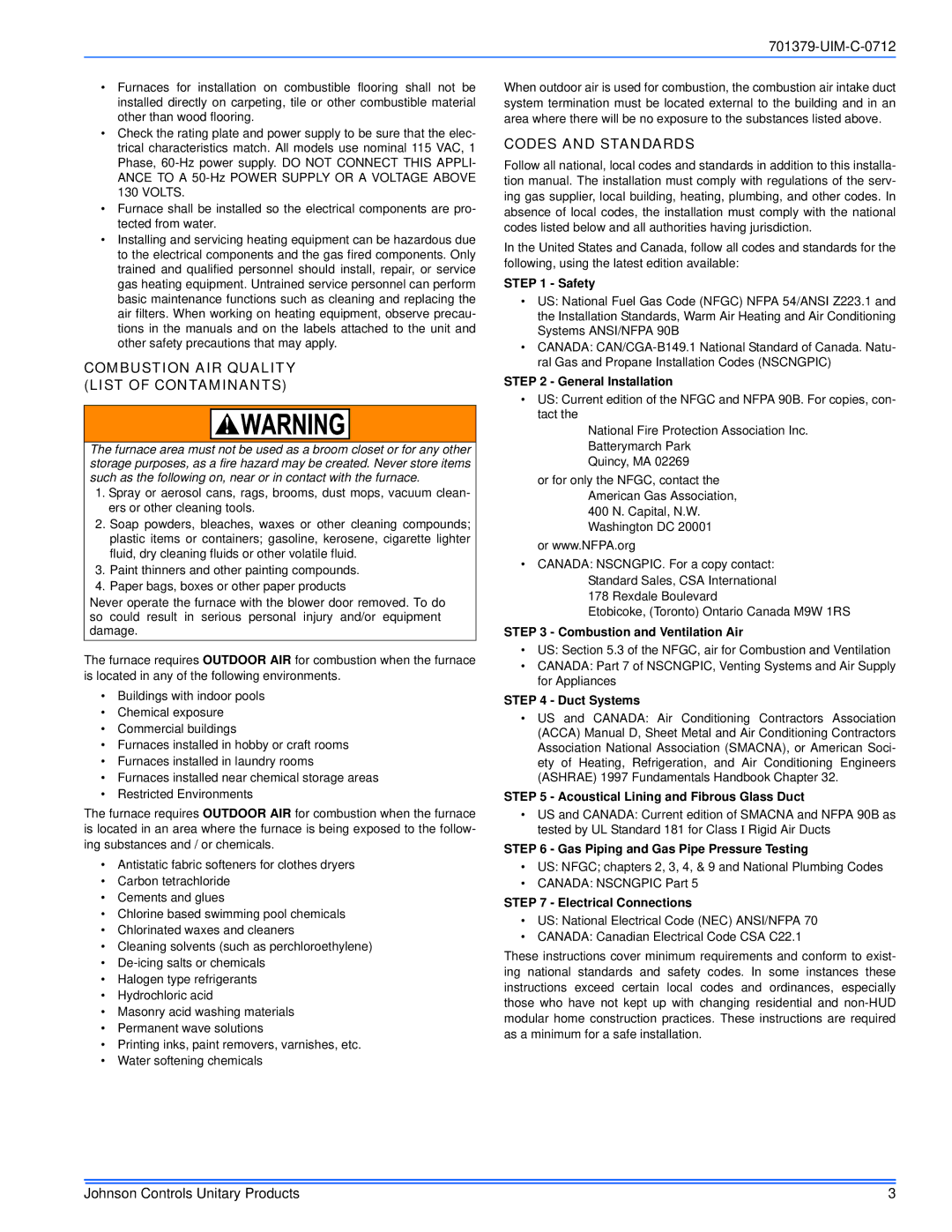•Furnaces for installation on combustible flooring shall not be installed directly on carpeting, tile or other combustible material other than wood flooring.
•Check the rating plate and power supply to be sure that the elec- trical characteristics match. All models use nominal 115 VAC, 1 Phase, 60-Hz power supply. DO NOT CONNECT THIS APPLI- ANCE TO A 50-Hz POWER SUPPLY OR A VOLTAGE ABOVE 130 VOLTS.
•Furnace shall be installed so the electrical components are pro- tected from water.
•Installing and servicing heating equipment can be hazardous due to the electrical components and the gas fired components. Only trained and qualified personnel should install, repair, or service gas heating equipment. Untrained service personnel can perform basic maintenance functions such as cleaning and replacing the air filters. When working on heating equipment, observe precau- tions in the manuals and on the labels attached to the unit and other safety precautions that may apply.
COMBUSTION AIR QUALITY (LIST OF CONTAMINANTS)
The furnace area must not be used as a broom closet or for any other storage purposes, as a fire hazard may be created. Never store items such as the following on, near or in contact with the furnace.
1.Spray or aerosol cans, rags, brooms, dust mops, vacuum clean- ers or other cleaning tools.
2.Soap powders, bleaches, waxes or other cleaning compounds; plastic items or containers; gasoline, kerosene, cigarette lighter fluid, dry cleaning fluids or other volatile fluid.
3.Paint thinners and other painting compounds.
4.Paper bags, boxes or other paper products
Never operate the furnace with the blower door removed. To do so could result in serious personal injury and/or equipment damage.
The furnace requires OUTDOOR AIR for combustion when the furnace is located in any of the following environments.
•Buildings with indoor pools
•Chemical exposure
•Commercial buildings
•Furnaces installed in hobby or craft rooms
•Furnaces installed in laundry rooms
•Furnaces installed near chemical storage areas
•Restricted Environments
The furnace requires OUTDOOR AIR for combustion when the furnace is located in an area where the furnace is being exposed to the follow- ing substances and / or chemicals.
•Antistatic fabric softeners for clothes dryers
•Carbon tetrachloride
•Cements and glues
•Chlorine based swimming pool chemicals
•Chlorinated waxes and cleaners
•Cleaning solvents (such as perchloroethylene)
•De-icing salts or chemicals
•Halogen type refrigerants
•Hydrochloric acid
•Masonry acid washing materials
•Permanent wave solutions
•Printing inks, paint removers, varnishes, etc.
•Water softening chemicals
When outdoor air is used for combustion, the combustion air intake duct system termination must be located external to the building and in an area where there will be no exposure to the substances listed above.
CODES AND STANDARDS
Follow all national, local codes and standards in addition to this installa- tion manual. The installation must comply with regulations of the serv- ing gas supplier, local building, heating, plumbing, and other codes. In absence of local codes, the installation must comply with the national codes listed below and all authorities having jurisdiction.
In the United States and Canada, follow all codes and standards for the following, using the latest edition available:
STEP 1 - Safety
•US: National Fuel Gas Code (NFGC) NFPA 54/ANSI Z223.1 and the Installation Standards, Warm Air Heating and Air Conditioning Systems ANSI/NFPA 90B
•CANADA: CAN/CGA-B149.1 National Standard of Canada. Natu- ral Gas and Propane Installation Codes (NSCNGPIC)
STEP 2 - General Installation
•US: Current edition of the NFGC and NFPA 90B. For copies, con- tact the
National Fire Protection Association Inc. Batterymarch Park
Quincy, MA 02269
or for only the NFGC, contact the American Gas Association, 400 N. Capital, N.W. Washington DC 20001
or www.NFPA.org
•CANADA: NSCNGPIC. For a copy contact:
Standard Sales, CSA International
178 Rexdale Boulevard
Etobicoke, (Toronto) Ontario Canada M9W 1RS
STEP 3 - Combustion and Ventilation Air
•US: Section 5.3 of the NFGC, air for Combustion and Ventilation
•CANADA: Part 7 of NSCNGPIC, Venting Systems and Air Supply for Appliances
STEP 4 - Duct Systems
•US and CANADA: Air Conditioning Contractors Association (ACCA) Manual D, Sheet Metal and Air Conditioning Contractors Association National Association (SMACNA), or American Soci- ety of Heating, Refrigeration, and Air Conditioning Engineers (ASHRAE) 1997 Fundamentals Handbook Chapter 32.
STEP 5 - Acoustical Lining and Fibrous Glass Duct
•US and CANADA: Current edition of SMACNA and NFPA 90B as tested by UL Standard 181 for Class I Rigid Air Ducts
STEP 6 - Gas Piping and Gas Pipe Pressure Testing
•US: NFGC; chapters 2, 3, 4, & 9 and National Plumbing Codes
•CANADA: NSCNGPIC Part 5
STEP 7 - Electrical Connections
•US: National Electrical Code (NEC) ANSI/NFPA 70
•CANADA: Canadian Electrical Code CSA C22.1
These instructions cover minimum requirements and conform to exist- ing national standards and safety codes. In some instances these instructions exceed certain local codes and ordinances, especially those who have not kept up with changing residential and non-HUD modular home construction practices. These instructions are required as a minimum for a safe installation.

